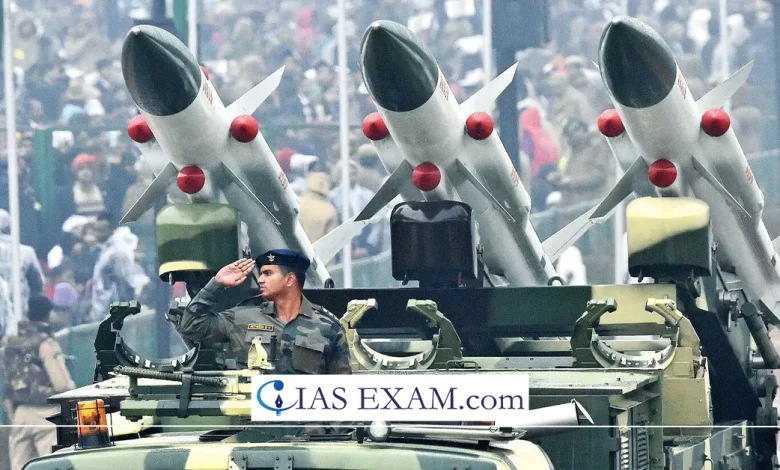Daily Current Affairs for UPSC
India’s defence exports reaches a record high
Syllabus- Internal Security [GS Paper-3]

Context
India’s defence exports reached a record high of Rs. 21,083 crore in FY 2023-24, marking a tremendous growth of 31 times over the past decade and a 32.5% increase from the previous fiscal year.
Key achievements
- Record High Exports: Indian defence exports reached an all-time high of Rs. 21,083 crores in FY 2023-24, indicating a huge growth trajectory.
- Remarkable Growth: The defence export area witnessed a tremendous growth of 31 times over the last decade, compared to FY 2013-14, showcasing sizeable expansion and development.
- Increased Export Authorizations: The number of export authorizations rose to at least one,507 in FY 2023-24, indicating a developing demand for Indian defence products and technology in the global market.
- Private Sector Contribution: The private zone performed a tremendous role, contributing about 60% to defence exports, highlighting the increasing participation and capability of private defence corporations in meeting export demands.
How does excessive defence export help India?
- Economic Growth: Boosts the economic system through expanded sales, task introduction, and more advantageous manufacturing competencies.
- It reduces India’s import dependence. India allocates around 1.8% of its GDP toward defence spending.
- Technological Advancement: Drives innovation and technological growth in the defence sector, fostering developments in different industries.
- Diplomatic Relations: Strengthens diplomatic ties with importing countries, facilitating strategic partnerships and cooperation.
- Global Influence: Enhances India’s stature in the global arena, positioning it as a reliable defence partner.
- India has been a success in exporting products such as personal protective items, offshore patrol vessels, and avionics to countries like Maldives, Sri Lanka, Russia, France, Nepal, Mauritius, Sri Lanka, Israel, Egypt, the UAE, and Chile.
- Self-Reliance: Reduces dependency on imports, selling indigenous production and self-sufficiency in defence skills.
- Military Modernization Supports modernization of armed forces by offering access to superior technology and equipment.
- Balance of Trade: Contributes to a high-quality balance of trade, helping to offset costs of defence procurement and imports.
- Integration with Global Defense Value Chain: Exporting defence products to major countries like Italy, Nepal, etc., integrates India into the global defence value chain, enhancing its strategic relevance and influence in the international arena.
Steps taken by India
- Enhanced Foreign Direct Investment (FDI): Liberalization of FDI coverage allowing up to 74% FDI under computerized course and 100% by authorities approval (e.g., the Swedish Arms Major SAAB’s Announcement: First 100% FDI undertaking for production of Carl Gustav M4 rocket system in India.)
- Innovation for Defence Excellence (iDEX): Launch of iDEX scheme involving Start-ups & Micro, Small and Medium Enterprises (MSMEs).
- Defence Acquisition Procedure (DAP) 2020: Implementation of recent procurement class – Buy (Global-Manufacture in India). The Defence Acquisition Procedure ensures 50% indigenous content in procurement.
- Establishment of Defence Industrial Corridors: Establishment of Defence Industrial Corridors in Uttar Pradesh and Tamil Nadu
- Priority to the procurement of capital items falling in the Buy Indian (IDDM) Category: Notification of four ‘Positive Indigenization Lists’ of a complete of 411 objects of Services and 3 ‘Positive Indigenization Lists’ of a complete of three,738 items of Defence Public Sector Undertakings (DPSUs).
- Increased Domestic Procurement Budget: From 40% to 75% of the total capital procurement price range dedicated to domestic procurement.
- DRDO: Review of Defence Research and Development Organisation (DRDO) and awareness on constructing “Fit to Purpose” competencies
- Participation of Women: Initiatives like Nari Shakti and the outlet of Sainik Schools and the National Defence Academy to ladies have significantly improved the participation of women in the armed forces.
- Naval Platform Development: Development of naval platforms which includes tasks like the INS Vikrant and Project 17A frigates.
Issues with India’s defence exports include
- Failure to Convert Interest into Business Action: Despite interest from countries like Indonesia, Malaysia, and others in products like BrahMos and Akash missile systems, India has struggled to translate this interest into concrete business deals.
- Inability to Secure Big Naval Defence Orders: India has confronted challenges in securing big naval defence orders from countries consisting of Oman, Myanmar, Mauritius, and Vietnam.
- Lack of Competitiveness: Indian defence products are frequently perceived as having lower exceptional and better expenses in comparison to primary exporters like the US, Russia, and Israel.
- Limited Export Portfolio: India’s defence exports are constrained to a few countries and product categories, hindering its ability to fully tap into the global defence market.
- Bureaucratic Hurdles: The defence export manner in India includes bureaucratic hurdles and purple tape, making it difficult for exporters to navigate.
- Unclear Policy: India lacks a well-defined defence export coverage, leading to confusion and uncertainty among potential exporters.
- Dependence on Imports: Despite strides in indigenization, India still is predicated heavily on imports for its defence system, proscribing its potential to export advanced defence technology.
Conclusion
- Self-reliance in defence manufacturing is significant not only effective for India’s defence capabilities however also for making sure sovereignty and security. Building a private commercial base with proactive policies, investment RnD, developing low-interest regimes to carry down capital costs, addressing problems of change quotes and supplying stability can help India’s defence manufacturing sector become globally competitive.
Source: The Indian Express
UPSC Mains Practice Question
Q.Foreign Direct Investment (FDI) in the defence sector is now set to be liberalized: What influence this is expected to have on Indian defence and economy in the short and long run? (2014)





.png)



